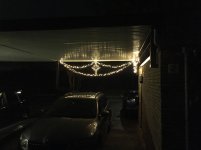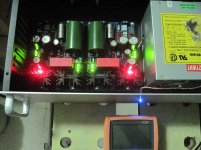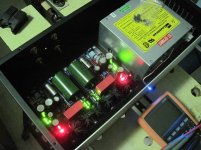I have finally completed my Salas FSP as can be seen in the attached photos. The raw dc board and the transformer are housed in a computer PS case feeding the two phono boards in one enclose. Things are a bit tight but it still works and sounds very good so far.
It is now working properly with 3.6V between TP1-TP2 on both channels. Voltage between Rail and Gnd is 32.16V (left) and 32.97V (right). The trick to reach the TP1-TP2 ballpark voltage is to keep turning VR2x. I found VR1's range to be very small.
For prospective builders, something I learned from my own experience is NOT to use metal spacers on the phono boards. I used these first and the leds would not light. I got worried and decided to replace them with nylon spacers. That restored my hope of finally listening to it!!
I haven't made extensive listening but first impressions are that it is very good. As I also built the original Salas project (from which the FSP was developed) I feel the latest design is better than the first in terms of detail and engagement - but not by a wide margin.
So THANK YOU Salas and all those who contributed to the FSP (CRT and T-bag come to mind) making it so readily available and accessible to non-technical builders like myself.
It is now working properly with 3.6V between TP1-TP2 on both channels. Voltage between Rail and Gnd is 32.16V (left) and 32.97V (right). The trick to reach the TP1-TP2 ballpark voltage is to keep turning VR2x. I found VR1's range to be very small.
For prospective builders, something I learned from my own experience is NOT to use metal spacers on the phono boards. I used these first and the leds would not light. I got worried and decided to replace them with nylon spacers. That restored my hope of finally listening to it!!
I haven't made extensive listening but first impressions are that it is very good. As I also built the original Salas project (from which the FSP was developed) I feel the latest design is better than the first in terms of detail and engagement - but not by a wide margin.
So THANK YOU Salas and all those who contributed to the FSP (CRT and T-bag come to mind) making it so readily available and accessible to non-technical builders like myself.
Attachments
I got a chance to listen to the FSP today with Jupiter Copper caps in the output. I haev to say it was really, really nice. We switched from Mundorf SIO. I am not going to say it trounced the SIO, but i definitely like the overall presentation a little better. Next weekend we will be putting a Vcap CUTF in the 47nF coupling position, as we got a deal on a pair. The FSP continues to be a stellar audio component.
Soniccraft in the U.S. has best prices I have found on them. We used 1uF as preamp has nice and high Zin. Also went with 100v version as it is being used in low voltage output of a RIAA. IMO, it is worth it. It is feeding a preamp based on very similar gain stage as FSP, Jfet with folded Bjt cascode. This is running into Pass INT-30a. We have only ventured into these choices because the rest of the system is set and will not likely change, so we are at final tweaking stage. It leaves little to be desired.
So THANK YOU Salas and all those who contributed to the FSP (CRT and T-bag come to mind) making it so readily available and accessible to non-technical builders like myself.
You are welcome. Try lower loss C3s than USSR NOS PIO sometime also. Teflon NOS for accessible cost or other good quality film type makes quite a difference in detail since the signal is still very small in that position. Talking from experience because I had tried that PIO vs its Teflon NOS brother there. Which phono cartridge you use?
Hi,
I am using two Galaxy Maggiorato cabinets with the option "invisible front plate fixing".
I am not aware of this option for the galaxy maggiorato cases. Could you point me to a link in the modushop website?
Just to confirm, when using the selectronics r core transformers one can use the 15v one as the output is higher that stated right?
http://www.selectronic.fr/transformateur-r-core-4-x-18v-2-x-115v.html
would this be a good choice if using a single transformer?
http://www.selectronic.fr/transformateur-r-core-4-x-18v-2-x-115v.html
would this be a good choice if using a single transformer?
Last edited:
It would bring 4x20 in real life, so when combined with each pair in series 2x40 and you will need experiment with RD/Link as the other guys. Its OK if you don't mind the procedure since its on promotion and cheaper than this one Transformateur R-CORE à fixation sur châssis 120VA - 2 x 30V - Promotions en cours that I believe possible it will bring bang on 2X34
Mudushop
Galaxy Maggiorato GX388 330 x 280 mm pannello frontale 10mm ARGENTO
Check on the left side..... option costs 7 euro's.
Cheers.
I am not aware of this option for the galaxy maggiorato cases. Could you point me to a link in the modushop website?
Galaxy Maggiorato GX388 330 x 280 mm pannello frontale 10mm ARGENTO
Check on the left side..... option costs 7 euro's.
Cheers.
I hope not............. when using the selectronics r core transformers one can use the 15v one as the output is higher that stated right?
Transformateur R-CORE - 4 x 18V - 2 x 115V - Promotions en cours................
The manufacturer should work to typical tolerances for the type.
If they use wider tolerances than is typical, then one would EXPECT them to specify their non standard tolerance.
If you mean that you know nothing about transformer regulation, then do some research.
Last edited:
Selectronic has added a line named "Tension à vide" I see, that probably refers to unloaded voltage if "vide" is related to "void" in French and I think its much nearer to lightly loaded real life expectation as when used for powering the FSP
I hope not.
Don't hope. I have used their 50VA 2x15 and it brings 17 to 17.5 on 230 VAC
if "Tension à vide : 20,3V" means open circuit voltage then one can calculate the transformer regulation.
But their numbers are weird.
120VA to 500VA gives reulation varying between 12.8% and 13.3%
50VA states x1.16. That may indicate 16%
30VA gives 32.2%
These are pretty poor regulation values !
But their numbers are weird.
120VA to 500VA gives reulation varying between 12.8% and 13.3%
50VA states x1.16. That may indicate 16%
30VA gives 32.2%
These are pretty poor regulation values !
Last edited:
Most manufacturers state the loaded voltage and the transformer regulation.Don't hope. I have used their 50VA 2x15 and it brings 17 to 17.5 on 230 VAC
If you measured the open circuit voltage, then a value of 17Vac for a 15Vac winding indicates a transformer regulation of 13.3%
Quoting 17Vac as the transformer voltage is not correct. If it were it would be indicating attrocious tolerances from that manufacturer.
The question was:
"when using the selectronics r core transformers one can use the 15v one as the output is higher that stated right?"
and I replied "I hope not"
I see a 230:15+15Vac 300VA stating:
That confirms your 17Vac as probably being an open circuit voltage. The transformer is still a 15Vac transformer, it is NOT a 16.9Vac transformer !Tension de sortie : 2x15V
Tension primaire : 1x230V
Tension à vide : 16,9V
Last edited:
For the FSP load ~100mA/channel situation we care here. For this purpose it will stay near the "vide" spec as it did when I used it. 46VDC rectified when FSP loaded. 233VAC averaging mains. Two 50VA ones with secondaries combined in series to one for each channel.
Has anyone built the FSP with the RIAA circuit and the PSU together in a single enclosure and compared it to a build with two separate enclosures? I have two enclosures that I intended to use for my FSP build, but i wonder if, with careful layout, a build in a single enclosure could be feasible.
- Home
- Source & Line
- Analogue Source
- Simplistic NJFET RIAA



